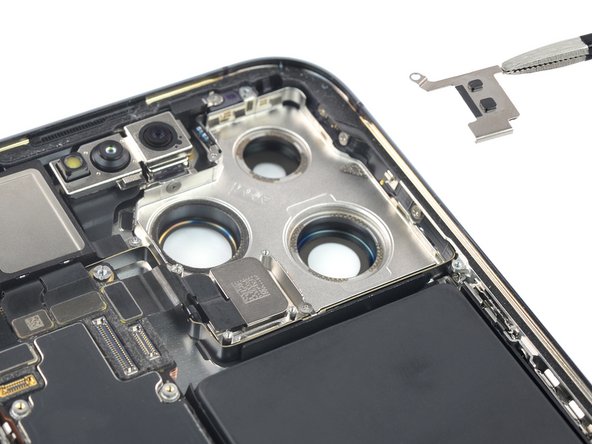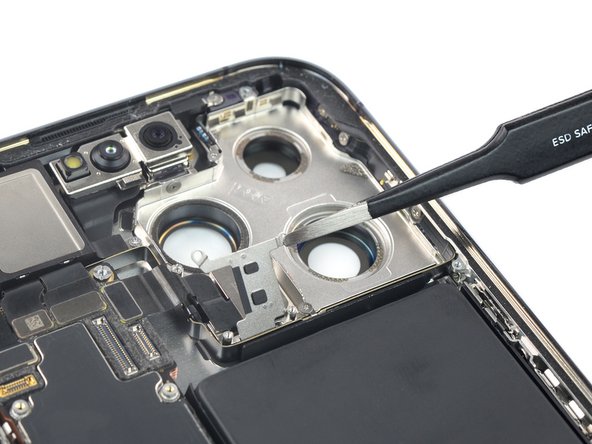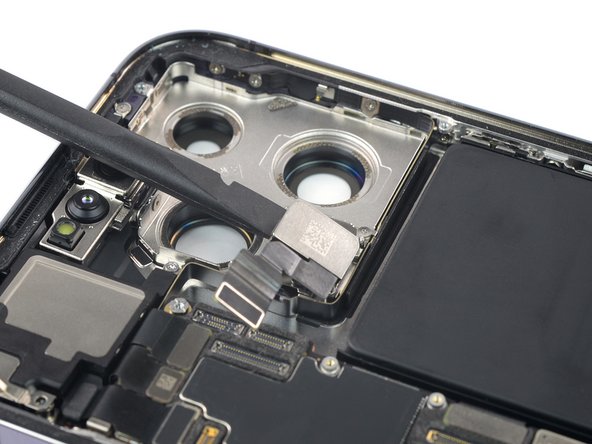iPhone 14 Pro Max Lidar Sensor Replacement
Duration: 45 minutes
Steps: 33 Steps
Ready to swap out that lidar sensor on your iPhone 14 Pro Max? Follow this guide to get your device back in action. We've based this on the A2894 (international) model, so if you're working with a different version, don't stress – the process will still be pretty similar, though there might be a few minor differences. Just a heads-up: when you reassemble, make sure you’ve got some fresh adhesive to secure the screen. Everything should work just fine after the repair, but keep in mind that your iPhone might lose its IP (Ingress Protection) rating in the process.
Step 1
- Make sure to power off your iPhone before you start taking it apart.
- Next, grab your pentalobe P2 screwdriver and remove the two 6.8 mm screws located at the bottom edge of the iPhone.
Step 2
Be careful not to push the opening pick in too deep—it could cause damage to your device. Use this step to mark your pick and keep things safe.
You can also mark the other corners of the pick with different measurements to stay on track.
Another trick: tape a coin 3mm from the tip of the pick to help guide you.
- Grab your trusty permanent marker and measure 3 mm from the tip of your opening pick. Mark it with the marker, and you're all set for the next step!
Step 3
Put on those safety glasses to keep your peepers safe from any sneaky glass shards that might pop out during the repair process!
Got a cracked iPhone screen? Keep those shards in check and avoid any ouchies by taping over the glass before you get to work.
If your suction cup refuses to stick, a little superglue can help it grip the screen like a champ.
- Cover the iPhone's screen with overlapping strips of clear packing tape until the entire front is sealed like a pro.
- If the suction cup isn’t cooperating in the next steps, no worries! Just fold a sturdy piece of tape (think duct tape) into a little handle and use that to lift the screen instead.
Tools Used
Step 4
The upcoming three steps show you how to use the Anti-Clamp, a handy tool we created to make prying open your device a breeze. If you’re not using the Anti-Clamp, just skip ahead three steps for another way to get inside.
For all the details on handling the Anti-Clamp like a pro, check out this guide.
If your iPhone’s surface feels too slick for the Anti-Clamp to grip, try adding some tape to give it a better hold.
- Pull the blue handle back to release the Anti-Clamp's arms.
- Slide the arms onto either the left or right edge of your iPhone.
- Place the suction cups near the bottom edge of the iPhone—one on the front side, the other on the back.
- Press the cups together to create a strong suction grip on the area.
Step 5
- Slide the blue handle forward to lock those arms in place.
- Give the handle a full 360-degree turn clockwise, or keep going until the suction cups start to stretch a bit.
- Keep an eye on the suction cups to make sure they stay lined up. If they start to drift, just loosen them a little and realign the arms.
Step 6
Give the Anti-Clamp a gentle quarter turn, then kick back for a minute before your next move. Slow and steady—let the tool do its thing!
Want to know how to use a hair dryer like a pro? Check out this guide for the full rundown.
If the Anti-Clamp isn't creating enough space, give it another blast of heat and try rotating the handle a quarter turn. That should do the trick!
- Place your iPhone on a solid surface like a hardcover book, keeping it steady and parallel to the floor. This makes the next steps a breeze!
- Grab a hair dryer and warm up the bottom edge of the iPhone until it feels just a tad too hot to touch. We want that adhesive to loosen up!
- Take a breather for a minute to let the adhesive relax and create a little opening for us.
- Once the Anti-Clamp has created a gap big enough, gently slide an opening pick under the screen's plastic bezel.
- Feel free to skip the next two steps!
Tools Used
Step 7
Keep your hair dryer moving—don’t let it chill in one spot for too long!
If you're rocking a suction handle, get ready to follow these next couple of steps to give that screen a little wiggle and loosen it up.
- Grab a hair dryer or heat gun and warm up the bottom edge of your iPhone for about 90 seconds, or until it feels just a bit too toasty to touch.
Tools Used
Step 8
The adhesive keeping that screen locked down is pretty strong, so it might take a bit of muscle to get that first gap going. If it's being stubborn, no worries—just heat things up a bit more and gently wiggle the screen up and down. That should loosen things up enough for you to slide in your opening pick. Patience is key!
- Stick a suction handle near the bottom of the screen, but steer clear of the very edge of the glass.
- Gently pull up on the suction cup with steady pressure to wiggle a small gap between the screen and the frame.
- Slide an opening pick into the gap just beneath the screen's plastic bezel to keep things moving.
Tools Used
Step 9
- Grab a hair dryer and warm up the right edge of your iPhone (yep, the side with the power button) for about 90 seconds or until it feels a bit too hot to touch. Just the right amount of warmth will make things easier later on.
Tools Used
Step 10
Be careful not to insert your pick more than 3 mm deep, or you might accidentally poke something important inside!
- Glide your opening pick along the bottom right curve of the iPhone—think of it as giving your phone a gentle nudge to loosen up the sticky adhesive.
- Keep that pick moving up the right edge, all the way to the top right corner. Smooth moves only!
- Pause for a moment and leave the pick chilling in the top right corner before you go on.
Step 11
- Grab a hair dryer and warm up the top edge of your iPhone for about 90 seconds, or until the screen feels just a bit too toasty to touch.
Tools Used
Step 12
Be careful not to push your pick in deeper than 3 mm; you wouldn't want to accidentally poke at the top sensors and cause some mischief!
- Slip your pick under the top right corner of the phone. Gently glide it around the corner and across the top edge, stopping just before you reach the earpiece speaker cut-out. You're doing great!
Step 13
- Grab your trusty hair dryer and aim it at the left edge of your iPhone! Give it a good 90 seconds of warmth or until it feels just a tad too hot to touch. You got this!
Tools Used
Step 14
Heads up! There are some fragile cables hanging out along the left edge of your iPhone. Avoid sliding your pick in there to keep everything safe and sound.
Step 15
Gently apply a twisting motion—slow and steady wins the race.
If the adhesive is putting up a fight, give the left edge a quick reheat and try again.
- Grab a second opening pick and gently slide it into the bottom left corner of your iPhone.
- Now, twist both picks at the same time, and watch as the left edge pops free from its clips!
Step 16
If you don’t have a spot to rest the screen on, no worries—just use your suction handle to hold it steady!
- Turn your iPhone so the right edge is facing you.
- Open your iPhone by gently lifting the screen from the right side, like flipping open a book.
- Rest the screen against something stable to keep it propped up while you work on the rest of the phone.
- When putting everything back together, position the screen, align the clips at the top edge, and carefully press the top edge into place before snapping the rest of the screen down. If it doesn't snap in easily, check the clips along the edges to make sure none of them are bent.
Tools Used
Step 17
Keep an eye on your screws and make sure each one finds its way back to its original spot—your iPhone will thank you for it!
- Grab your trusty Y000 screwdriver and carefully unscrew the eight screws holding the battery connector cover in place. Easy peasy!
- Before you seal everything up, this is a perfect time to power on your iPhone and check that everything is functioning as it should. Just remember to power it down completely before diving back in!
- You'll need six screws that are 1.3 mm long.
- Don't forget about that one 1.6 mm long screw!
- And keep an eye out for the one 1.9 mm long screw too!
Step 18
- Grab the connector cover with some tweezers and gently slide it down to free up those flex cables.
- Carefully lift off the connector cover.
Tools Used
Step 19
Handle the black silicone seal around this and other board connections with care! These little guys are your best friends when it comes to keeping out pesky water and dust.
- Grab the pointed end of your spudger and gently lift the battery connector out of its socket. It’s a little tug, but nothing too crazy!
- Once it’s free, bend the connector away from the logic board. This will stop it from making any accidental contact and turning the phone back on during your repair. Safety first!
Tools Used
Step 20
- Grab your trusty spudger and use its pointed end to gently pry the first display cable straight up from its socket. Easy does it!
- When it's time to re-attach connectors like this one, take a moment to line them up carefully. Press down on one side until you hear that satisfying click, then do the same on the other side. Remember, avoid pressing down in the middle! If things get misaligned, those little pins can bend and that’s a no-go. If you find yourself in a pickle, don’t hesitate to schedule a repair.
Tools Used
Step 21
- Grab your trusty spudger and gently use its pointed end to pop that second display cable right out of its socket. Go ahead, give it a little nudge upwards and watch it disconnect like magic!
Tools Used
Step 22
- Carefully remove the screen.
- Once the screen is off, clean up the areas with some isopropyl alcohol (>90%)—then add new adhesive where it's needed.
- When you're putting it back together, feel free to stop here if you're planning on replacing the screen adhesives.
Step 23
- Grab your trusty Y000 screwdriver and unscrew the five screws holding that rear camera assembly cover in place. You've got this!
- Next up, take your Phillips screwdriver and carefully remove that 1.7 mm screw. Just one little guy, no biggie.
- Now, go ahead and remove the four 1.5 mm Y000 screws. One by one, keep it steady!
- Finally, take out that lone 1.2 mm Y000 screw. It's small but mighty, so don't miss it!
Step 24
There's a small metal lip at the top right corner of the camera cover, held in place by the phone frame. A little tricky, but no worries, just take your time and you'll be good to go!
- Use a pair of tweezers to gently grab the rear-facing camera assembly cover.
- Slide the camera cover toward the volume buttons to carefully release its small metal edge from the frame.
- Take out the rear-facing camera assembly cover.
- When putting things back together, make sure the camera cover is lined up just right and press the small metal edge back into its spot in the frame.
Tools Used
Step 25
- Take your trusty spudger and gently pop up the connector for the ultra wide and telephoto lens cable—just lift it straight out of its socket.
Tools Used
Step 26
- Grab your trusty spudger and gently work it under the wide lens cable. Once you've got it, carefully lift the connector straight up from its socket. Nice and easy—don't force it!
Tools Used
Step 27
- Slide the sharp tip of your trusty spudger right under the bottom edge of that rear-facing camera assembly. You're doing great!
- Now, give the back of the spudger a gentle tilt downwards to pop up the rear-facing camera assembly. Keep it going!
Tools Used
Step 28
- Grab some tweezers or just your fingers and carefully pop out the rear-facing camera assembly.
Tools Used
Step 29
- Grab your standoff screwdriver and carefully twist out the 2.8 mm standoff screw holding down that lidar sensor cover.
Step 30
- Grab your trusty tweezers and gently pop off that lidar sensor cover like a pro!
Tools Used
Step 31
- Grab your trusty spudger and gently pop the lidar sensor cable connector up from its socket. Easy does it—no need to flex those muscles!
Tools Used
Step 32
- Slide the flat end of a spudger under the top edge of the lidar sensor.
- Gently tilt the back of the spudger downward to lift the lidar sensor free.
Tools Used
Step 33
- If you can, power up your device and give your repair a test run before you go all in with the adhesive and sealing it up tight.
- Take a moment to compare your new replacement part with the original—you might need to move over some leftover bits or peel off those pesky adhesive backings from the new part before it fits in.
- To put your device back together, just retrace your steps in reverse order.
- Don’t forget to take your e-waste to an R2 or e-Stewards certified recycler—let's keep our planet happy!
- Things didn’t go quite as you hoped? No worries! Give some basic troubleshooting a shot, or if you’re feeling stuck, don’t hesitate to schedule a repair for some extra help.






















































































